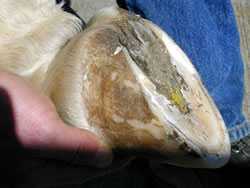Should a horse have its frog and sole trimmed? Dr. Joyce Harman explains how trimming affects the natural foot of the horse.
Question: My farrier is very conscientious and appears well trained with recent schooling. I’m puzzled by the fact that he trims the frog and some of the sole of the hoof. I ride my horse a lot, sometimes on gravel, stony roads. Doesn’t my horse need all that frog and hoof thickness? He avoids rocky sections of the road whenever possible in favor of the grassy edges.
Answer: There are many schools of thought about hoseshoeing and trimming the barefoot horse. It can open a can of worms to talk to different people about the subject. However, the barefoot horses feet are perhaps the most important part of the body–as the old saying goes, no foot, no horse. I feel it is very important that you, as the owner, learn as much as possible about your barefoot horse, so you can take responsiblility for making decisions about foot care, as you do about other aspects of horse care. You are responsible for selecting your trainer, veterinarian, hay and feed suppliers, saddles and other gear, so foot care fits in well here. If you are uncomfortable or unhappy with any of your present team, you can make a change to someone you feel is better for you and your barefoot horse.
As you select your support team members, including farriers, look for people who include you in the decision-making process, keep you informed about their thinking and who behave professionally. If something is not working, always try first to talk to the individual about your concerns and evaluate the answer before just jumping ship and looking for someone else. Many times you can work out the issues.
When it comes to feet, it is most important to understand how the natural foot of the horse behaves in different situations, both with shoes and without. The purpose of the hoof wall is to protect the coffin bone, to provide support for the body and renew itself as it wears down. It needs to be strong, flexible and a correct shape. The shape can vary a bit depending on the conformation, but in reality, well-trimmed feet are fairly similar in shape, with a short toe, strong heels , a large frog and strong bars. Having said that, there are horses who have very poor shapes to their feet, or have very different shaped feet no matter how well trimmed they are.
In most cases it is not necessary and not desirable to trim away frong and live sole, but it is commonly done. The foot needs the full shape of the frog to help with expansion, contraction and blood flow. The sole is there for protection from the ground. The only trimming needed on the sole is to remove flaky, dead sole. Any live sole that does not flake away easily should be left for the horse. If you ride regularly or the horse is in rough pasture, there likely will be very little sole to take off, ever. If the horse stands in a stall most of the time and is ridden on soft ground, there may be more sole to remove. Some horses, even with thick soles, do not like the hard, sharp, gravely part of the road, but your horse may be telling you his soles are trimmed too thin.
Even more important is the sole callus, the thicker band of sole that goes across the toe area. This provides support to the inside of the foot (the laminae that connect the hoof wall to the coffin bone). Many farriers cut that off as a routine, however, it should never be cut off, only made level with the shoe if the horse is to be shod, and not touched if the horse stays barefoot. If it is cut thin at shoeing, frequently the horse will be sore for a few days after each shoeing–this is not normal and does indicate too much is being trimmed.

The toes should be short so the horse can roll over his toes easily. A common fault in shoeing is to leave the toes too long, whether the horse is a barefoot horse or shod.
To learn more about horses’ feet and trimming, check out www.hopeforsoundness.com and www.hoofrehab.com . Many people are learning to trim their own horse’s feet, which is good if you get training and keep learning. Do not fall into the trap of thinking that every horse’s feet can be made the same or trimmed the same way. Also, it is not fair or humane to the horse to remove the shoes and have him sore for the next year while his feet grow out. Use hoof boots, get assistance or put the shoes back on if your horse is not comfortable with the change. A few weeks of being a little sore is OK, but more than that is not. It does take time to learn trimming and it is a lot of physical work. You will gain a new respect for farriers if you try some trimming yoursellf.
Posted by Nancy Fredrick




